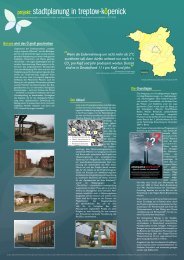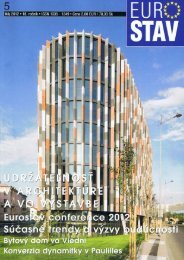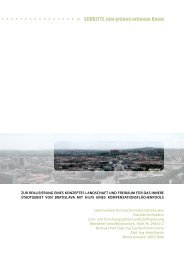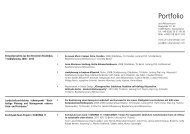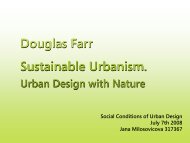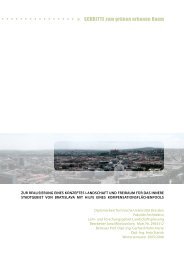crease lower, the urban geometry parameters would be less significant.Additionally, a cooling effect during the summer months would be expected.Unfortunately, to my knowledge, temperature measurementsof that extent – e.g. covering a street with/and without vegetated builtsurfaces in the same geographic and microclimatic conditions – confirmingthis hypothesis, have not been taken yet.For the above mentioned reasons, we can state that although the urbangeometry is widely acknowledged being one of the most significantfactors determining incoming solar radiation and hence the urban temperaturesand the UHI extent – there is no “right” H/W ratio (orsky view factor – SVF 22 ) generally applicable in all conditions.As such, we could pursue the H/W ratio of 0.4-0.6 advocated by Okeand Emmanuel only if the streetscape wouldn’t consist of dark, impermeablepaving and of buildings built with conventional, heat-absorbingmaterials but would involve sufficient greening measures, low-albedosurfaces and overground rainwater catchment elements. On the otherhand, the streets could be narrower (H/W ratio higher 1) if the coolingeffect of roof- and façade greenery would compensate the exceedinganthropogenic heat loads. In other words, it is the low levels of surfacesealing and greening of open space and buildings that help lower theUHI intensity (and the street orientation and design that supports ventilation,as will be discussed later) in any given urban geometry conditions.The H/W aspect however correlates with the previously discussedaspect of urban density, where certain limits should not be exceeded inorder to avoid too high levels of anthropogenic heat emission.AbsorptionSolar radiationSurface reflectanceSurfacereflectanceFig. 26 Albedo reflection and radiation absorption.In urban environment, the reflectedradiaton will remain within the street profile;being partially reflected but also absorbed byother surfaces. Thus the absorption (and hencelocal surface temperature) will be lower but theoveral radiation (heat) not minimized.The building volumes are another factor determining urban geometry.The larger the surface of buildings, the higher the reflectionrate (multiple reflection of the shortwave radiation, fig. 26) and thehigher absorption of solar radiation and later release in formof heat. Therefore, the volume to surface area ratio of buildings canbe considered having an impact on urban temperatures and climate.Comparing a living area for 10 families, each occupying a 100 m 2 largeliving space in different housing types 23 : (a) one-storey detached, (b)two-storeys row houses, (c) multi-unit building, (d) ten-storey building;the compact multi-unit building proves to be the most preferableone because it has the smallest proportion of walls and roofsand thus is most likely to avoid multiple sunlight reflection and solarradiation absorption, as well as the emmitance of heat from buildingsthrough walls. The highest surface to living area ratio comes in case ofdetached housing (fig. 27).It should be noted that the particular use of buildings – for housingpurposes or as offices etc. – does not have any considerable influenceon the climatic effects of the buildings in general, only their physicalstructure (Zentralinstitut für Raumplanung und Umweltforschung TUM1995).22 The urban geometry may also be expressed by the ‘sky view factor’ (SVF, fig.25). This factor would be equal 1.0 in case of unobstructed horizontal area; “fora point surrounded by close and very high buildings, or for a very narrow street,it may be about 0.1” (Givoni 1998, p. 252).23 Given that the geometry conditions are simplified and the buildings have flatroofs.Fig. 27 The larger the buildings’ surface in urbanareas, the higher the effect of multiple reflectionof short-wave radiation and thus higherabsorption of the solar radiation and its laterrelease in form of heat.Surface calculation of different housing typesthat accomodate ten identical living units á 100m 2 in form of:a) detached houses - total buildings‘ surface2200 m 2b) row houses - total surface 1220 m 2c) units in a multi-storey building (incl. verticalinfrastructure area) - total surface 1140 m 2c) units in a high-rise building (incl. vertical infrastructurearea) - total surface 1370 m 2showed, that a compact, multi-unit buildinghas the smallest proportion of surface to theused space.a)b)c)d)2 Literature review: The impact of built structures on climate, energy flow and the water cycle25
Impact of the street orientation on insolationThe streets’ orientation affects the solar exposure of open areasand buildings as well as the comfort of people walking in the streets.In moderate climates, the objectives on this subject are rather complicated:To provide maximum shade in summer and maximum impingingsolar radiation in the winter. These requirements are difficult to satisfy,as in the summer, the sun stands high on the sky and thus reaches thestreet level easier than in winter, when the radiation angle is considerablylower and the street better protected by buildings from directsolar radiation. There is only deciduous vegetation in form of robust,solar-friendly trees that is able to oblige the human physical comfortdemand, providing shade in summer and letting insolation penetratethrough the thin branches in the winter. In this case, the South-Northorientation of the streets would prove to be most convenient, allowingsunlight reaching the streets’ ground level in the winter.When aiming to alleviate the impacts of the summer heat waves, however,the heating-up effect of the urban canyons must be considered.A study by Herrmann & Matzarakis (2010, p. 525-526) showed that aNorth-South oriented street reaches very high temperatures, while inthe case of East-West oriented urban canyons, the temperatures wereconsiderably lower. 24 Although this study has been conducted on anidealized canyon model, it implies that East-West oriented streetcanyons (and canyons oriented in a small angle to this direction)are optimal in moderate climate. What additionally affects thetemperatures in street canyons is the ventilation, discussed below.VentilationStrong airflow in the streetThe air circulation is essential in mitigation of extremely high temperatures,due to the ability of the wind to transfer cool air from vegetatedareas in the direction of urban cores, pushing the hot air in the centreupwards. Thus, considerable attention will be given to ventilationaspects in this <strong>Thesis</strong>. The main urban design features that affect thewind conditions are 25 :0 - ca. 10°Fig. 28 Streets parallel or in an small angle (ofup to 10°) to the prevailing wind direction.1.2.3.4.The overall urban density;Combined impact of street orientation and width of the streets;Ventilation channels, open spaces and green shelter belts – theiravailability, size distribution and design details.Height and shape of the individual buildings and the existence ofhigh-rise buildings;Downwind street side with stronger air flowUpwind street side with gentler air flow1. The urban density affects the ventilation conditions in the streets,as well as the potential for natural ventilation of buildings. This effect,however, depends greatly on the details of the urban physical structure.Even in dense urban areas, it is possible to obtain a wide range ofwind conditions by applying different urban design approaches. For ex-The higher street width, the better air circulationFig. 29 Streets oriented oblique to the prevailingwind direction.24 Canyons rotated in between the two main directions showed step-wise modificationin the temperatures, North-South and East-West orientations being the twoextrema.25 Givoni 1998, p. 261; modified and completed26Climate Sensitive <strong>Urban</strong> <strong>Design</strong> in Moderate Climate Zone: Responding to Future Heat Waves. Case Study Berlin Heidestrasse/Europacity



